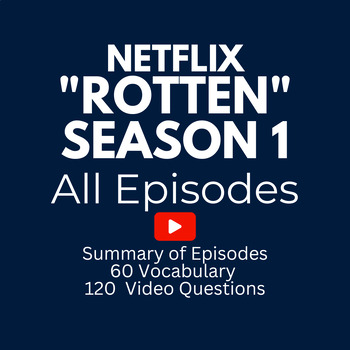"Rotten" Season 1- 6 Episodes Summary, Vocabulary Terms, and Movie Questions
- Open Publication Structure eBook File
Description
Introducing "Rotten: Season 1 All Six Episodes, summaries, tier 2 vocabulary, and over 120 student questions"
Explore the fascinating world of the global food industry with your students through this comprehensive educational package. From honey to fish, these six gripping episodes uncover hidden truths and complex issues. Tailored for high school science and environmental teachers, this guide offers episode summaries, over 60 tier 2 vocabulary words, and 120 engaging questions in both EPUB and PDF formats. (e-pub use online and pdf print out)
Episode 1: "Lawyers, Guns & Honey"
- Uncover the honey industry's hidden challenges and the importance of bees in our ecosystem.
- Vocabulary: Adulteration, Ecosystem, Sustainability...
Episode 2: "The Peanut Problem"
- Explore the alarming rise in food allergies and the impact on society and the environment.
- Vocabulary: Allergens, Food Safety, Immunology...
Episode 3: "Garlic Breath"
- Dive into the intricacies of garlic farming, trade, and the global impact on economy and sustainability.
- Vocabulary: Agriculture, Trade Regulations, sustainability, etc.
Episode 4: "Big Bird"
- Discover the complexities of chicken farming and the environmental and ethical concerns related to it.
- Vocabulary: Poultry Industry, Ethics, Environmental Impact...
Episode 5: "Milk Money"
- Investigate the dairy industry's evolution and its relationship with health, economy, and ethics.
- Vocabulary: Dairy Farming, Nutrition, Bioethics...
Episode 6: "Cod is Dead"
- Learn about the collapse of the cod fishing industry and the essential lessons in environmental management.
- Vocabulary: Overfishing, Marine Ecosystems, Resource Management...
✅ What's Included?
- 6 Detailed Summaries: Easy-to-follow guides for each episode.
- Over 60 Tier 2 Vocabulary Words: Key terms related to the food industry, ecology, and global economics.
- 120 Engaging Questions: Thought-provoking questions for classroom discussion, homework, or quizzes.
Call to Action: Bring real-world science and environmental issues to life in your classroom with "Rotten: A Study Guide for Science & Environmental Education." Engage your students, stimulate critical thinking, and foster an appreciation for our complex world. Tap into this invaluable resource today!


